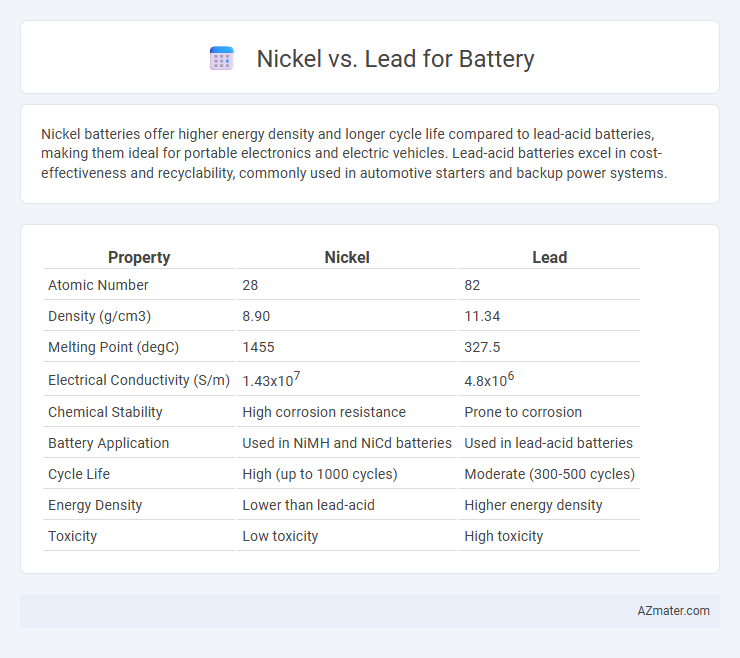Nickel batteries offer higher energy density and longer cycle life compared to lead-acid batteries, making them ideal for portable electronics and electric vehicles. Lead-acid batteries excel in cost-effectiveness and recyclability, commonly used in automotive starters and backup power systems.
Table of Comparison
| Property | Nickel | Lead |
|---|---|---|
| Atomic Number | 28 | 82 |
| Density (g/cm3) | 8.90 | 11.34 |
| Melting Point (degC) | 1455 | 327.5 |
| Electrical Conductivity (S/m) | 1.43x107 | 4.8x106 |
| Chemical Stability | High corrosion resistance | Prone to corrosion |
| Battery Application | Used in NiMH and NiCd batteries | Used in lead-acid batteries |
| Cycle Life | High (up to 1000 cycles) | Moderate (300-500 cycles) |
| Energy Density | Lower than lead-acid | Higher energy density |
| Toxicity | Low toxicity | High toxicity |
Introduction to Nickel and Lead Batteries
Nickel batteries, including nickel-cadmium (NiCd) and nickel-metal hydride (NiMH), are known for their high energy density, long cycle life, and ability to perform well in a wide temperature range. Lead-acid batteries, widely used in automotive and backup power applications, offer low cost and reliable performance but have lower energy density and shorter cycle life compared to nickel-based batteries. The choice between nickel and lead batteries depends on factors such as energy requirements, weight constraints, cost considerations, and application-specific demands.
Chemical Composition and Structure
Nickel-based batteries, such as nickel-cadmium (NiCd) and nickel-metal hydride (NiMH), utilize nickel hydroxide as the positive electrode, offering higher energy density and better charge retention compared to lead-acid batteries. Lead-acid batteries consist of lead dioxide and sponge lead plates immersed in sulfuric acid electrolyte, providing robust structure but lower energy density and shorter cycle life. The crystalline structure of nickel hydroxide facilitates faster electrochemical reactions, whereas the lead plates' porous structure supports high current discharge but limits overall efficiency.
Energy Density Comparison
Nickel-based batteries, such as nickel-cadmium (NiCd) and nickel-metal hydride (NiMH), exhibit higher energy density ranging from 60 to 120 Wh/kg compared to lead-acid batteries, which typically offer 30 to 50 Wh/kg. This increased energy density enables longer runtimes and lighter battery systems in applications like electric vehicles and portable electronics. The superior energy storage capacity of nickel batteries contributes significantly to improved performance and efficiency over lead-based alternatives.
Lifespan and Cycle Durability
Nickel-based batteries, such as nickel-metal hydride (NiMH) and nickel-cadmium (NiCd), typically offer a longer lifespan and higher cycle durability compared to lead-acid batteries, often exceeding 1000 charge-discharge cycles. Lead-acid batteries generally have a shorter cycle life, around 200 to 500 cycles, due to sulfation and electrolyte degradation issues. The enhanced cycle durability of nickel batteries makes them more suitable for applications requiring frequent deep cycling and extended operational longevity.
Charging Efficiency and Speed
Nickel-based batteries, such as nickel-metal hydride (NiMH), generally offer faster charging speeds and higher charging efficiency compared to lead-acid batteries due to their lower internal resistance and better charge acceptance. Lead-acid batteries require longer charging times and exhibit lower charging efficiency because of sulfation and energy loss during the charging process. High charging efficiency in nickel batteries results in reduced energy consumption and improved cycle life, making them preferable for applications demanding rapid recharge and frequent cycling.
Environmental Impact and Toxicity
Nickel batteries typically offer a lower environmental impact compared to lead-acid batteries due to higher energy density and longer lifecycle, reducing waste and resource consumption. Lead batteries pose significant toxicity risks because lead is a heavy metal that can cause soil and water contamination, necessitating strict recycling processes to mitigate environmental damage. Nickel-based batteries generally present fewer health hazards during use and disposal, promoting safer handling and reduced ecological footprint.
Cost Analysis and Market Availability
Nickel batteries typically have higher upfront costs compared to lead-acid batteries due to advanced materials and manufacturing processes, but they offer longer lifespans and better energy density, reducing total cost of ownership over time. Lead-acid batteries remain more affordable initially and have widespread market availability, making them a preferred choice for budget-sensitive applications despite lower energy efficiency. Market trends indicate increasing demand and improved supply chains for nickel-based batteries driven by electric vehicles and renewable energy storage growth.
Common Applications and Use Cases
Nickel-based batteries, especially nickel-metal hydride (NiMH) and nickel-cadmium (NiCd), are commonly used in hybrid vehicles, power tools, and portable electronics due to their high energy density and long cycle life. Lead-acid batteries dominate automotive starting, lighting, and ignition (SLI) applications, as well as uninterruptible power supplies (UPS) and large-scale energy storage, valued for their low cost and reliable power delivery. The choice between nickel and lead batteries depends on factors like energy density, weight, cost, and application-specific durability requirements.
Safety Considerations and Risks
Nickel-based batteries, such as nickel-metal hydride (NiMH), offer enhanced thermal stability and lower risk of leakage compared to lead-acid batteries, reducing the likelihood of hazardous chemical exposure. Lead-acid batteries contain toxic lead and sulfuric acid, posing significant environmental and health risks if damaged or improperly handled. Proper ventilation and recycling protocols are essential for lead-acid battery safety, while nickel batteries require attention to overcharging and temperature management to prevent thermal runaway.
Future Trends in Battery Technology
Nickel-based batteries, particularly nickel-cobalt-aluminum (NCA) and nickel-manganese-cobalt (NMC) chemistries, dominate future energy storage trends due to higher energy density and longer cycle life compared to lead-acid batteries. Innovations in nickel battery technology focus on enhancing safety, reducing cobalt content, and improving fast-charging capabilities, making them ideal for electric vehicles and renewable energy storage. Conversely, lead-acid batteries persist in low-cost, stationary applications but face obsolescence driven by the superior performance and environmental benefits of advanced nickel-based systems.

Infographic: Nickel vs Lead for Battery
 azmater.com
azmater.com